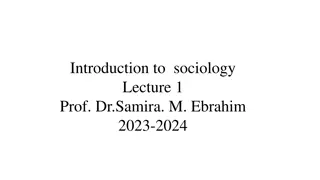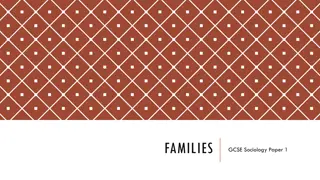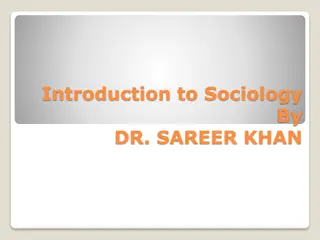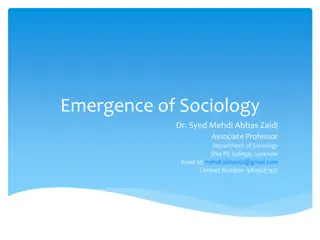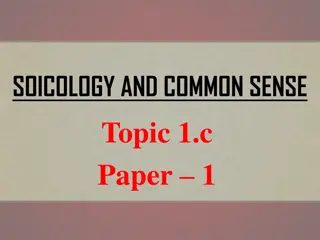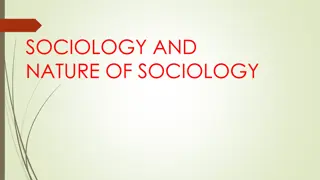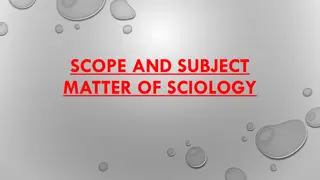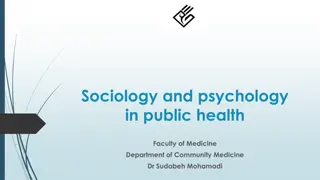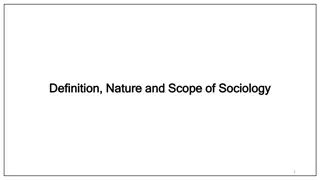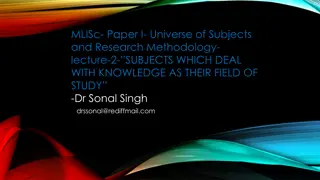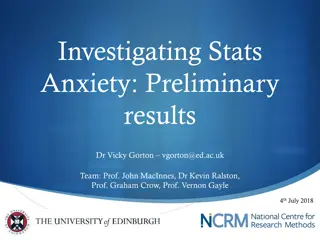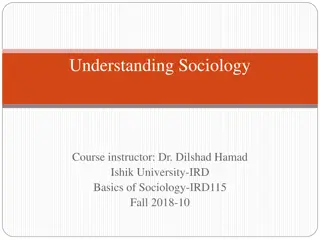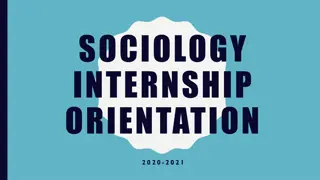Evolution of Sociology: Key Figures and Societal Analysis
Explore the evolution of sociology through the contributions of leading sociologists like Auguste Comte, Emile Durkheim, and Karl Marx. Understand the impact of different types of societies, cultural elements, and societal changes. Dive into the intricate web of cultural life in the United States and beyond, examining subcultures and the formation of a whole culture.
Download Presentation

Please find below an Image/Link to download the presentation.
The content on the website is provided AS IS for your information and personal use only. It may not be sold, licensed, or shared on other websites without obtaining consent from the author. Download presentation by click this link. If you encounter any issues during the download, it is possible that the publisher has removed the file from their server.
E N D
Presentation Transcript
describe the development of the field of sociology.[SOC.1A] October 2014 SOCIOLOGY
identify leading sociologists in the field of social science, including Auguste Comte, Emile Durkheim, Herbert Spencer, Max Weber, and Karl Marx, and interpret their contributions to the foundation of sociology.[SOC.1B] October 2014 SOCIOLOGY
identify sociologists such as W. E. B. DuBois, Booker T. Washington, Robert E. Park, Harriet Martineau, Jane Addams, Robert Nisbet, and Julian Samora and interpret their contributions to the field.[SOC.1C] October 2014 SOCIOLOGY
differentiate types of societies such as hunting and gathering, agrarian, pastoral, industrial, and post- industrial.[SOC.2A] October 2014 SOCIOLOGY
identify and describe the types of societies that exist in the world today.[SOC.2B] October 2014 SOCIOLOGY
examine changes in U.S. institutions and society resulting from industrialization, urbanization, and immigrant assimilation.[SOC.2C] October 2014 SOCIOLOGY
analyze information about cultural life in the United States and other countries over time.[SOC.2D] October 2014 SOCIOLOGY
identify the elements of culture to include language, symbols, norms, and values.[SOC.3A] October 2014 SOCIOLOGY
explain how the elements of culture form a whole culture.[SOC.3B] October 2014 SOCIOLOGY
give examples of subcultures and describe what makes them unique.[SOC.3C] October 2014 SOCIOLOGY
describe models of primary, secondary, formal, informal, and reference groups and e- communities.[SOC.4A] October 2014 SOCIOLOGY
analyze groups in terms of membership roles, status, values, mores, role conflicts, and methods of resolution.[SOC.4B] October 2014 SOCIOLOGY
compare cultural norms such as ethnicity, national origin, age, socioeconomic status, and gender among various U.S. subculture groups.[SOC.5A] October 2014 SOCIOLOGY
describe stereotypes of various U.S. subcultures.[SOC.5B] October 2014 SOCIOLOGY
analyze social problems in selected U.S. subcultures.[SOC.5C] October 2014 SOCIOLOGY
examine counterculture movements and analyze their impact on society as a whole.[SOC.5D] October 2014 SOCIOLOGY
define socialization and describe how the process of socialization is culturally determined.[SOC.6A] October 2014 SOCIOLOGY
differentiate the agents of socialization and evaluate their functions and roles.[SOC.6B] October 2014 SOCIOLOGY
trace socialization as a lifelong process.[SOC.6C] October 2014 SOCIOLOGY
explain how education, exclusion from the labor force, and the juvenile justice system led to the development of adolescence as a distinct stage of the life cycle.[SOC.7A] October 2014 SOCIOLOGY
identify and interpret the five characteristics of adolescence: biological growth and development, an undefined status, increased decision making, increased pressures, and the search for self.[SOC.7B] October 2014 SOCIOLOGY
identify issues and concerns facing contemporary adolescents such as dating, dating violence, sexuality, teen parenting, drug use, suicide, and eating disorders.[SOC.7C] October 2014 SOCIOLOGY
identify and discuss the skills adolescents need to make responsible life choices.[SOC.7D] October 2014 SOCIOLOGY
identify the stages of adult development and compare the differences between male and female development.[SOC.8A] October 2014 SOCIOLOGY
analyze the traditional roles of work and how the composition of the labor force has changed in the United States.[SOC.8B] October 2014 SOCIOLOGY
analyze the characteristics of late adulthood and changes on the individual and society such as retirement, physical and mental functioning, dependency on others, and death.[SOC.8C] October 2014 SOCIOLOGY
compare theories of deviance such as the functionalist, conflict, and interactionist perspectives.[SOC.9A] October 2014 SOCIOLOGY
interpret differences in crime and arrest rates by social categories such as ethnicity, gender, socioeconomic status, and age, including cross-reference with the National Crime Victimization Survey.[SOC.9B] October 2014 SOCIOLOGY
analyze the criminal justice system in the United States in relation to deviant behavior.[SOC.9C] October 2014 SOCIOLOGY
analyze the characteristics and components of caste and class systems and social mobility and how motivation affects each.[SOC.10A] October 2014 SOCIOLOGY
define poverty and its components and analyze poverty's impact on the individual and society.[SOC.10B] October 2014 SOCIOLOGY
contrast theories of social stratification.[SOC.10C] October 2014 SOCIOLOGY
recognize and examine global stratification and inequality.[SOC.10D] October 2014 SOCIOLOGY
define race and ethnicity and differentiate among the distinguishing characteristics of minority groups.[SOC.11A] October 2014 SOCIOLOGY
contrast the terms discrimination, prejudice, and bias.[SOC.11B] October 2014 SOCIOLOGY
discuss the ramifications of stereotyping.[SOC.11C] October 2014 SOCIOLOGY
analyze the varying treatment patterns of minority groups such as African American, Asian American, Hispanic American, and American Indian.[SOC.11D] October 2014 SOCIOLOGY
explain instances of institutional racism in American society.[SOC.11E] October 2014 SOCIOLOGY
analyze how gender roles affect the opportunities available to men and women in society.[SOC.12A] October 2014 SOCIOLOGY
analyze the effects of an aging society.[SOC.12B] October 2014 SOCIOLOGY
compare the nature of health care in a global society.[SOC.12C] October 2014 SOCIOLOGY
evaluate the nature of health care in different segments of American society.[SOC.12D] October 2014 SOCIOLOGY
define the functions and rituals of the family and how the family has changed over time.[SOC.13A] October 2014 SOCIOLOGY
define family systems and patterns.[SOC.13B] October 2014 SOCIOLOGY
analyze the trends in American society regarding family life and the needs that the institution of family satisfies.[SOC.13C] October 2014 SOCIOLOGY
analyze ways in which family life can be disrupted.[SOC.13D] October 2014 SOCIOLOGY
define and differentiate between the economic models of free enterprise and socialism and how they impact society.[SOC.14A] October 2014 SOCIOLOGY
define and differentiate among different types of government and discuss the legitimacy of those in power and the impact of each on its citizens.[SOC.14B] October 2014 SOCIOLOGY
trace the changes in ideas about citizenship and participation of different groups through time.[SOC.14C] October 2014 SOCIOLOGY
explain functionalist, conflict, and interactionist theories of education.[SOC.15A] October 2014 SOCIOLOGY



